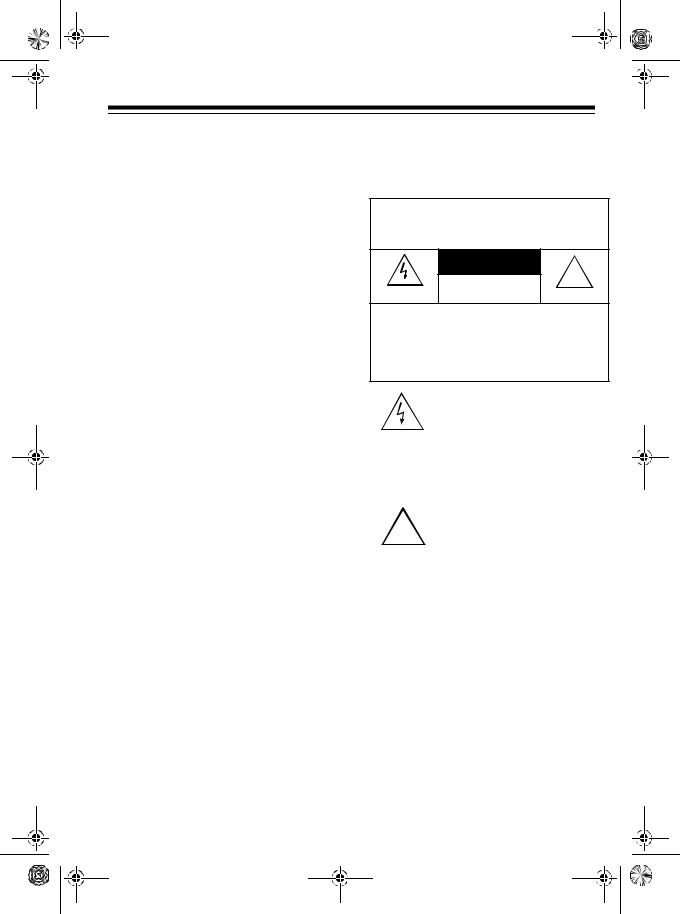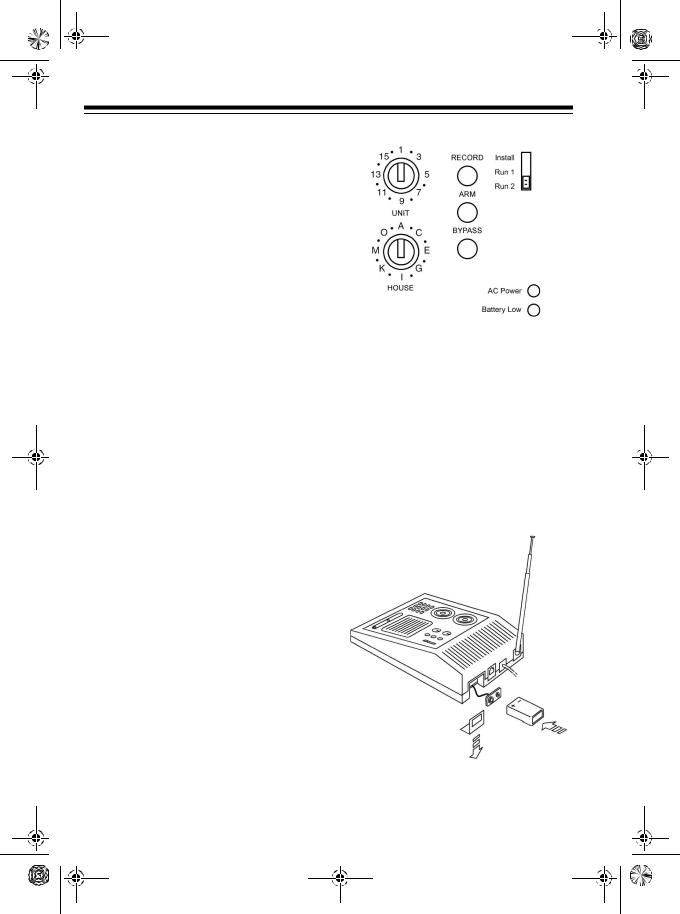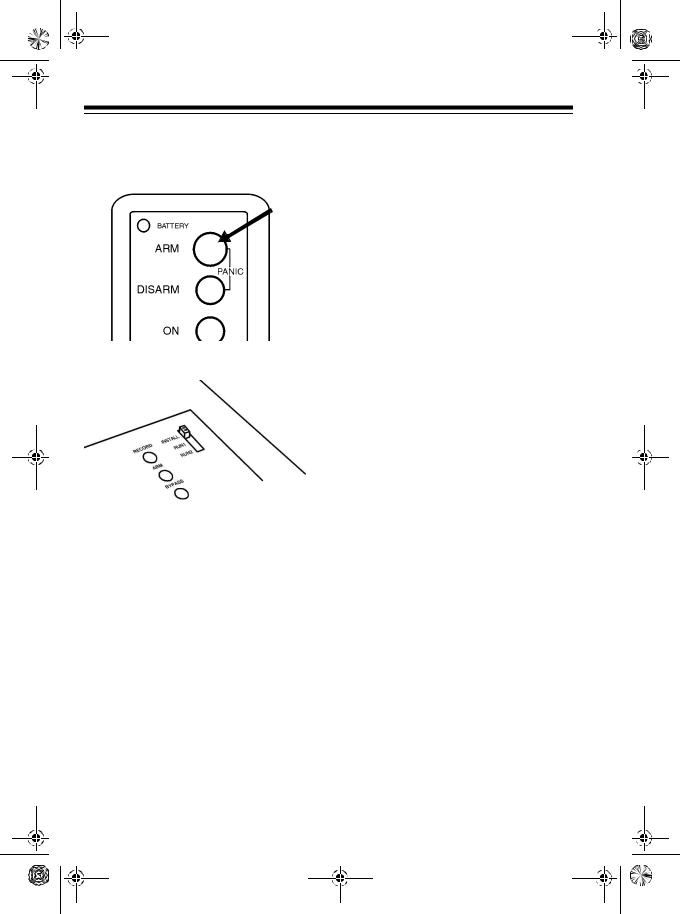Radio Shack 49-2551A User Manual

49-2551AB.fm Page 1 Friday, February 19, 1999 3:41 PM
Cat. No. 49-2551A B
OWNER’S MANUAL
Please read before using this equipment.
Wireless Home Security System
with Emergency Phone Dialer Plug ,n Power® Compatible

49-2551AB.fm Page 2 Friday, February 19, 1999 3:41 PM
INTRODUCTION
You can install your RadioShack Wireless Home Security System with Emergency Phone Dialer anywhere in your house using the existing house wiring. The system operates using radio frequencies, thus eliminating the need for additional wiring. It includes a handheld remote, one keychain remote, two wireless sensor transmitters, a motion detector, and a lamp module so you can immediately begin using your system. The console can monitor up to 16 security zones (with additional remote sensors) and sound its built-in alarm when a violation occurs in any zone.
Here are some of the features of your system.
Two Wireless Sensor Transmitters
— trigger the console’s built-in alarm when a secured door or window opens (additional sensors, RadioShack Cat. No. 49-2585).
Handheld Remote — lets you arm and disarm the system and control the lights connected to Plug ’n Power modules (additional handheld remotes, Cat. No. 49-2551T).
Keychain Remote — lets you conveniently arm and disarm the system as you come and go and turn on/off lights and appliances (additional keychain remotes, Cat. No. 49-2591).
Lamp Module — lets you turn on/off a lamp using a remote control. The lamp also flashes on and off during an alarm (additional lamp modules, Cat. No. 612682).
Motion Detector — protects an area where an intruder might enter (additional motion detectors, Cat. No. 492589).
Plug ’n Power Compatible Design — lets you add a total of 16 wireless sensor transmitters, lamp modules, motion detectors, and other accessories to customize your home security system.
Supervised Operation — keeps track of each wireless sensor transmitter’s status and alerts you if there is a problem (such as an intrusion or a low battery).
Built-In Telephone Voice Dialer — dials a friend or neighbor and plays back your recorded message when a violation occurs.
Please read this entire manual carefully so you understand how to correctly install and use this security system.
©1999 Tandy Corporation. All Rights Reserved.
RadioShack and Plug ’n Power are registered trademarks used by Tandy Corporation.
2

49-2551AB.fm Page 3 Friday, February 19, 1999 3:41 PM
Notes:
•In addition to the parts provided, you need one 9V alkaline battery to operate the console; six AAA alkaline batteries — two to operate the keychain remote control and four to operate the handheld remote control; and eight AA alkaline batteries — two in each wireless sensor transmitter and four to operate the motion detector. Alkaline batteries in these sizes, are available from your local RadioShack store.
•The suitability of this system to perform as a burglar alarm system or as an emergency service device has not been evaluated by Underwriters’ Laboratories, Inc.
•The wireless sensor transmitters are supplied with NC (Normally Closed) magnetic switches.
•You cannot use NO (Normally Open) magnetic switches with this sensor.
Warning: To prevent fire or shock hazard, do not expose this product to rain or moisture.
WARNING: To reduce the risk of fire or shock hazard, do not expose this product to rain or moisture.
CAUTION |
! |
RISK OF ELECTRIC |
SHOCK. DO NOT OPEN.
CAUTION: TO REDUCE THE RISK OF ELECTRIC SHOCK, DO NOT REMOVE COVER OR BACK. NO USER-SERVICE- ABLE PARTS INSIDE. REFER SERVICING TO QUALIFIED PERSONNEL.
This symbol is intended to alert you to the presence of uninsulated dangerous voltage within the product’s enclosure that might be of sufficient magnitude to constitute a risk of electric shock. Do not open the product’s case.
This symbol is intended to inform you that important operating and ! maintenance instructions are included in the literature accom-
panying this product.
3

49-2551AB.fm Page 4 Friday, February 19, 1999 3:41 PM
READ THIS BEFORE INSTALLATION
Your console's telephone dialer is designed to conform to federal regulations, and you can connect it to most telephone lines. However, each telephone or telephone device that you connect to the telephone line draws power from the telephone line. We refer to this power draw as the device's ringer equivalence number, or REN. The REN is on the bottom of the console.
If you use more than one telephone or other device on the line, add up all the RENs. If the total is more than five, your telephones might not ring. In rural areas, a total REN of three might impair ringer operation. If ringer operation is impaired, remove one of the devices from the line.
Note: You must not connect your console to:
•coin-operated systems
•party-line systems
•most electronic key telephone systems
Your console's telephone dialer complies with Part 68 of FCC Rules. You must, upon request, provide the FCC registration number and the REN to your telephone company. Both numbers are on the bottom of the console.
4
THE FCC WANTS YOU TO KNOW
In the unlikely event that your security console dialer causes problems on the phone line, the phone company can temporarily discontinue your service.
If this happens, the phone company attempts to notify you in advance.
If advance notice is not practical, the phone company notifies you as soon as possible and advises you of your right to file a complaint with the FCC.
Also, the phone company can make changes to its lines, equipment, operations, or procedures that could affect the operation of this telephone. The telephone company notifies you of these changes in advance, so you can take the necessary steps to prevent interruption of your telephone service.

49-2551AB.fm Page 5 Friday, February 19, 1999 3:41 PM
CONTENTS |
|
Glossary ................................................................................................................. |
7 |
Planning Your Security System........................................................................... |
8 |
Assigning Security Codes ............................................................................... |
9 |
Reassigning Security Codes ........................................................................... |
9 |
Quick Installing/Testing Your System............................................................... |
10 |
Setting Up The Console ................................................................................ |
10 |
Installing the Keychain Remote Control ........................................................ |
11 |
Installing the Handheld Remote Control ........................................................ |
12 |
Initializing the Wireless Sensor Transmitters ................................................. |
13 |
Initializing the Motion Sensor ........................................................................ |
14 |
Installing the Lamp Module ........................................................................... |
15 |
Testing the System ........................................................................................ |
16 |
Mounting Accessories ...................................................................................... |
17 |
Mounting the Wireless Sensor Transmitters .................................................. |
17 |
Mounting the Motion Detector ....................................................................... |
18 |
Making a Pet Zone ........................................................................................ |
20 |
Testing the Motion Detector .......................................................................... |
20 |
SETTING UP THE TELEPHONE DIALER ......................................................... |
22 |
Setting up Phone Numbers ........................................................................... |
22 |
Recording a Voice Message ......................................................................... |
24 |
Testing the Dialer .......................................................................................... |
25 |
OPERATION ........................................................................................................ |
26 |
Arming/Disarming the System ...................................................................... |
26 |
Arm Away/Arm Home ............................................................................. |
26 |
Instant/Delay Mode ................................................................................. |
26 |
Using the Panic Alarm ................................................................................... |
27 |
Zone Indicators ............................................................................................. |
27 |
Reading the Status of Zones 1–8 ........................................................... |
28 |
Trouble Alarm ......................................................................................... |
28 |
Reading the Status of Zones 9–16 ......................................................... |
28 |
Other Console Indicators ........................................................................ |
29 |
During an Alarm ............................................................................................ |
29 |
After an Alarm ............................................................................................... |
29 |
Controling Plug ’N Power Modules ................................................................ |
29 |
Turning Modules On/Off .......................................................................... |
29 |
Using Security Light................................................................................. |
30 |
Using Bright/Dim ..................................................................................... |
30 |
Resetting the Console ................................................................................... |
30 |
|
5 |

49-2551AB.fm Page 6 Friday, February 19, 1999 3:41 PM
Troubleshooting ................................................................................................. |
31 |
Care and Maintenance ....................................................................................... |
36 |
Replacing the Console’s Battery ................................................................... |
37 |
Replacing a Remote’s Batteries .................................................................... |
37 |
Replacing a Wireless Sensor Transmitter’s Batteries .................................... |
38 |
Intercom Systems .......................................................................................... |
38 |
FCC Cautions ................................................................................................ |
39 |
Lightning ........................................................................................................ |
39 |
6

49-2551AB.fm Page 7 Friday, February 19, 1999 3:41 PM
GLOSSARY
Here are a few terms that will be helpful to understand as you read this manual.
Arm and Disarm — Terms for on and off. When you arm the system, you turn on protection. Disarming the system turns off protection.
Away Mode — Your system’s armed mode when all sensors (including motion detectors) are armed.
Console — The system’s main control panel.
Entry/Exit Delay — A setting on the hand-held remote control that allows you time while entering and exiting your house before the system arms or the alarm trips.
Home Mode — The system’s armed mode when only doors and windows are armed (not motion detectors). This prevents you from accidentally tripping the motion detector(s) yourself as you move around the house.
Instant Mode — A way of arming the system so the alarm immediately trips if a wireless sensor transmitter set to INSTANT or the motion detector reports an intrusion.
Note: The keychain remote control only arms the system in the instant mode.
Motion Detector — Senses motion by detecting a change in temperature when an intruder walks across its path.
Remote Control — A device that lets you arm and disarm the system away from the console.
Violation — An alarm condition, such as that caused by an opened door or window, detected by a sensor.
Wireless Sensor Transmitter — Triggers the alarm when a secured door or window opens.
Zone — The area protected by a wireless sensor transmitter, a motion detector, or other sensing/transmitting device.
7

49-2551AB.fm Page 8 Friday, February 19, 1999 3:41 PM
PLANNING YOUR SECURITY SYSTEM
Before you set up your system, make a security plan of your home. This is especially important if you install multiple sensors to protect several different zones.
Even if you only install the supplied sensors, take time to think about the best location for them. If you live in an upstairs apartment, the front door might be the best place to mount a wireless sensor transmitter. If you live in a house or downstairs apartment, you might want to cover a back door and/or window.
Start by drawing a simple floorplan of your home, which you can use through all stages of planning your system.
Your security system has three goals:
•to prevent loss by discouraging potential intruders
•to scare intruders away before they can take your property or break into your home
•to alert you or others that someone is breaking into your home
To help accomplish these goals, you should:
•Post decals on doors and windows stating that your home is protected by a security system. Decals (Cat. No. 49-507) are available at your local RadioShack store.
•Choose a location for the console where it is not easily accessible or seen by intruders.
In addition, most police departments offer information that might be helpful. After making a preliminary plan, contact your local police department to see if they offer guidelines or other services for planning a home security system.
8

49-2551AB.fm Page 9 Friday, February 19, 1999 3:41 PM
ASSIGNING SECURITY CODES
A security zone is an area of protection covered by a single wireless sensor transmitter, motion detector, or other sensing/transmitting device. Your security console monitors up to 16 zones and alerts you if there is a violation (see “Zone Indicators” on Page 27).
When you initialize your security system’s sensors, the console assigns a zone number to the sensor (see “Initializing the Wireless Sensor Transmitters” on Page 13). The system includes numbered stickers you attach to each sensor to show its zone number. For your reference, make a record of which area of your home a zone covers. For example, using the floorplan you drew, you could mark the front door as “Zone 1.”
REASSIGNING
SECURITY CODES
If you want to remove one accessory, reassign an accessory to a zone currently in use, or add an accessory when all zones are assigned, you must completely reinitialize the entire system.
To reinitialize the system, unplug the console and remove its battery backup. The console loses all stored codes. Then reinitialize all remote controls, wireless sensor transmitters, and motion detectors, assigning each accessory to the desired zone.
9

49-2551AB.fm Page 10 Friday, February 19, 1999 3:41 PM
QUICK INSTALLING/TESTING YOUR SYSTEM
This section describes how to initialize all of the system’s accessories so they are recognized by the console and how to test the system to make sure it is working properly. Perform all the procedures in this section, then follow the instructions in “Mounting Accessories” on Page 17.
You can add other separately purchased accessories to the system by following the appropriate initialization and testing procedures in this section.
SETTING UP THE
CONSOLE
1.Choose a location for the console that is:
•close to a telephone jack so you can easily connect the telephone dialer
•central to the doors/windows you want to protect so all sensors are within range of the console (100 feet)
•positioned where you can easily check the zone indicators for any problems, but not where an intruder could easily see it
2.Set the house and unit code dials on the console to A1.
Note: You can set the console to any house code, but you must also set all accessories/sensors to the same house code.
3.Place the telescoping antenna in an upright position and fully extend it.
4.For backup power in case of an AC power failure, place a 9-volt alkaline battery in the battery compartment. See “Replacing the Console’s Battery” on Page 37.
10

49-2551AB.fm Page 11 Friday, February 19, 1999 3:41 PM
Note: Be sure to install the backup battery. If there is no battery and the console loses AC power, you must re-initialize all of the system’s accessories.
5.Plug the console into any standard AC outlet that is not controlled by an on/off switch.
6.Plug the telephone cord into the console and plug the other end into a modular phone jack.
•If you do not have a modular phone jack, you can either update the wiring yourself or have the phone company do it for you. RadioShack stores sell the jacks and adapters you need. The USOC number of the jack to be installed is RJ11C for a baseboard jack or RJ11W for a wall jack.
Notes:
•If you do not have an unused jack, use the supplied duplex adapter. For a baseboard jack, plug the adapter into the jack; for a wall jack, plug the adapter into the console.
INSTALLING THE KEYCHAIN REMOTE CONTROL
1.Slide off the keychain remote control’s battery compartment cover. Install two AAA alkaline batteries in the compartment, according to the polarity symbols (+ and –) marked inside. Then replace the compartment’s cover.
11

49-2551AB.fm Page 12 Friday, February 19, 1999 3:41 PM
2.Press ARM on the remote control. The indicator on the remote control blinks.
3.Set the console’s INSTALL/RUN 1/ RUN 2 switch to INSTALL.
4.Stand near the console and press ARM again. The indicator blinks again, and the console chimes and logs in the remote control.
5.Leave the console’s switch set to INSTALL to install other accessories.
Notes:
•You can add any combination of up to eight Plug ’n Power remote controls.
•When you press a button, BATTERY lights on the remote control to show the battery is good.
12
INSTALLING THE HANDHELD REMOTE CONTROL
1.Press the tab on the battery compartment cover and lift off the cover.
2.Install four AAA alkaline batteries in the handheld remote control’s battery compartment, according to the polarity symbols (+ and –) marked inside the compartment.
Still Missing-Paste in this illustration at Proof to Mass Print stage.
3.Be sure the console’s INSTALL/ RUN 1/RUN 2 switch is set to
INSTALL.
4.Set the house code on the remote control to the same letter as the console.
5.Press ARM HOME or ARM AWAY on the handheld remote control. The console chimes.
